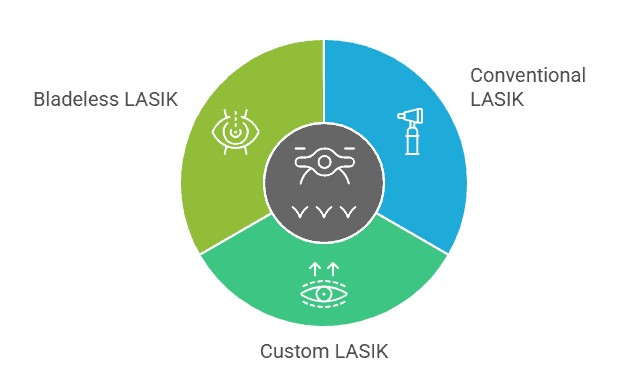
Last Updated on October 4, 2025 by Aaron Barriga
There are three kinds of people: those who love flaunting their quirky and cool glasses, second who swear by contact lenses, and the third group consists of those who can’t wait to get rid of glasses/contact lenses. If you fall in the third category, then LASIK is your savior.
LASIK, which stands for Laser in-situ Keratomileusis, is a corrective surgery used to fix common vision problems such as near-sightedness, far-sightedness, or astigmatism. It uses a specialized laser known as an ‘excimer’ laser, which reshapes the cornea to give better, clearer, and focused vision. Excimer laser precisely removes extremely tiny amounts of tissue without disturbing adjacent tissues.
Types of LASIK Eye Surgery
 There are three types of LASIK procedures. Consultation with your doctor will help in determining which one will give you the best results.
There are three types of LASIK procedures. Consultation with your doctor will help in determining which one will give you the best results.
Conventional LASIK
This primarily uses your prescription for contact lenses or eyeglasses. Based on that, laser settings are determined to reshape the cornea. The level and accuracy of vision correction is similar to that of the familiar procedure of choosing glasses in a vision test – “Which offers better clarity: this or that?”
Custom LASIK
Custom LASIK allows surgeons to customize laser treatment according to patients’ individual eyes. It uses Wave Front technology that creates a customized map of all unique attributes of your eye. This further enables your surgeon to address the unique visual correctional requirements of an individual. Surgeons can achieve sharper and clearer vision by addressing higher-order aberrations and correcting refractive errors, including subtle vision problems.
Bladeless LASIK
Bladeless LASIK eliminates the need for blades to cut corneal flaps before surgery. It uses a gentle laser instead of a manual blade to create a uniform and precise corneal flap. The laser is operated at an extremely high speed and is controlled by a computer, which allows the tissue to be targeted and divided at a molecular level without damaging the surrounding tissue. Recovery time is faster since the flap is more accurate and falls back naturally into place.
Also read: Differences Between Blade Vs Bladeless LASIK Surgery
Costs of LASIK Eye Surgery
The cost of LASIK surgery varies according to geographic location, the surgical experience of the doctor, and the technology used. Avoid those who present extremely low prices and shady offers. Risking the safety of your eyes to save a few bucks may end up costing you more in the long run.
On average, LASIK eye surgery (blade) costs about $1,700 per eye. Alternatively, state-of-the-art technologies such as bladeless Custom-Wavefront LASIK can be around $2,500 per eye. Depending on the eye’s health and the magnitude of the vision problem, the cost may even go up to $4,000 per eye.
Typically, insurance does not cover the cost of laser eye surgery unless your job requires perfect vision. Combat fighters and athletes usually qualify for full insurance coverage. Feel free to ask your insurance company for negotiated rates and membership discounts that are applicable to AAA holders or those in the military.
US employees have an FSA, HSA, or HRA to cover health expenses with income-tax-free accounts. The cost of laser eye surgery is an eligible expense for all these accounts. Check with your tax preparer if you qualify for the same.
Also read: How Much Does LASIK Eye Surgery Cost?
Ready for Clear Vision?
Experience the freedom of life without glasses or contacts. Book your LASIK consultation today at Insight Vision Center and take the first step towards a brighter, clearer future.

Dr. Azhar I. Salahuddin is an ophthalmologist and is fellowship-trained in cornea, external diseases, and refractive surgery. Dr. Salahuddin has been performing cataract surgery for over 19 years and specializes ocular reconstruction, corneal transplantation surgery as well as vision correction through a variety of intraocular lenses. Dr. Salahuddin is board-certified by the American Board of Ophthalmology and was trained at Boston University.

